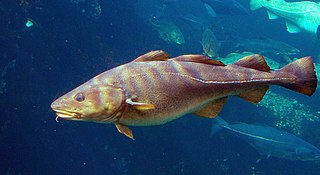
Cod is the common name for the demersal fish genus Gadus, belonging to the family Gadidae. Cod is also used as part of the common name for a number of other fish species, and one species that belongs to genus Gadus is commonly not called cod.

The haddock is a saltwater ray-finned fish from the family Gadidae, the true cods. It is the only species in the monotypic genus Melanogrammus. It is found in the North Atlantic Ocean and associated seas where it is an important species for fisheries, especially in northern Europe where it is marketed fresh, frozen and smoked; smoked varieties include the Finnan haddie and the Arbroath smokie.

Arctogadus glacialis, known also with ambiguous common names Arctic cod and polar cod, is an Arctic species of fish in the cod family Gadidae, related to the true cod. Arctogadus glacialis is found in icy water. They grow to about 30 cm long, and are favorite food of narwhals and other arctic whales.

Grenadiers or rattails are generally large, brown to black gadiform marine fish of the subfamily Macrourinae, the largest subfamily of the family Macrouridae. Found at great depths from the Arctic to Antarctic, members of this subfamily are amongst the most abundant of the deep-sea fish.
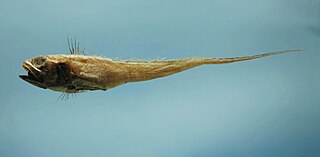
Macroudidae is a family of deep sea fish, a diverse and ecologically important group, which are part of the order of cod-like fish, the Gadiformes. The species in the Macrouridae are characterised by their large heads which normally have a single barbel on the chin, projecting snouts, and slender bodies that taper to whip-like tails, without an obvious caudal fin but what there is of the caudal fin is often confluent with the posterior dorsal and anal fins. There are normally two dorsal fins, the anterior dorsal fin is quite high, the posterior quite low but is longer and takes up a greater proportion of the fish's of the back, species in the subfamily Macrouroidinae have a single dorsal fin. The long anal fin is almost as long as the second dorsal fin is nearly as long as the posterior dorsal, and sometimes it is longer. The pelvic fin is inserted in the vicinity of the thorax and normally has 5-17 fin rays but are absent in Macrouroides. The body is covered in small scales and if they have a photophore, it is usually on the midline of the abdomen just in front of the anus. The bioluminescence of these fish is produced by symbiotic bioluminescent bacteria. The structure of the skull has been used to show their placing in the Gadiformes, but they differ from the typical cods in that they possess one stout spine in the anterior dorsal fin.
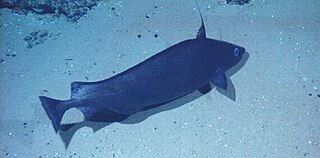
The blue antimora, also known as the flat-nose codling, blue hake, long-finned cod or violet cod, is a benthopelagic species of morid cod of the genus Antimora, found in seas around the world on the continental shelf except the north Pacific. This bluish-black species may be found at depths of between 350 and 3,000 m(1,148 to 9.843 ft) ,but it is commonly found at depths of 800-1800m. Its length is between 40 and 75 cm. It is of minor importance to commercial fisheries.

The northern bastard codling is a morid cod of the genus Pseudophycis, found around southern Australia including Tasmania, and New Zealand, from the surface to 220 m. Its length is between 15 and 25 cm.

Helicolenus percoides, the reef ocean perch, coral cod, coral perch, Jock Stewart, kuriarki, ocean perch, red gurnard perch, red gurnard scorpionfish, red ocean perch, red perch, red rock perch, scarpee or sea perch, is a species of marine ray-finned fish belonging to the subfamily Sebastinae, part of the family Scorpaenidae. It is found in the southwestern Pacific Ocean.

Coryphaenoides is a genus of rattails which is found in all oceans of the world. They are found in deep waters and C. yaquinae, recorded to 7,012 m (23,005 ft), is the only member in the family known from the hadal zone.

Physiculus is a genus of morid cods.
The Tasmanian codling is a species of morid cod only known from the waters around Tasmania and the Australian states of Western Australia and Victoria. It is found in relatively shallow waters at depths from 8 to 12 m. This species grows to 26 cm (10 in) in total length. This is the only known species in its genus.
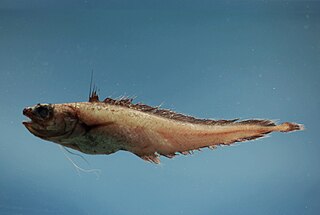
Laemonema is a genus of morid cods.
Notophycis is a genus of morid cods.
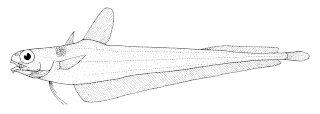
Tripterophycis is a genus of morid cods.
The Panama hake, also known as the dwarf hake, is a merluccid hake of the genus Merluccius, found off the west coast of the Americas from Del Mar, California, to Ensenada de Tumaco, Colombia.

Trachyrincus scabrus, the roughsnout grenadier or Mediterranean longsnout grenadier, is a species of bathydemersal marine fish from the subfamily Trachyrincinae, part of the family Macrouridae. It is found in the eastern Atlantic Ocean and the Mediterranean.
Merluccius hernandezi, the Cortez hake, is a species of fish from the family Merlucciidae, the true hakes. It is endemic to the Gulf of California where it can be found in the epipelagic and mesopelagic zones over the continental shelf, open sea, and sea mounts, to a depth of around 300m. It is a small species which has been referred to as a "dwarf hake" and is of little interest to fisheries, other than small scale local fisheries. It was described in 1985 and small hake in the Gulf of California were previously considered to be Panama hakes. This species differs from the Panama hake in that in juveniles the caudal fin has a central lobe and is truncate in adults, whereas the caudal fin is emarginate in the Panama hake, its pectoral fin projects well beyond the anus in but does not do so in the Panama hake.
Merluccius polli, the Benguela hake, is a species of fish from the family Merlucciidae, the true hakes. It is found in the tropical waters of the eastern Atlantic Ocean off the west coast of Africa.

Gadella maraldi, the gadella or morid cod, is a species of fish in the family Moridae from the warmer waters of the north eastern Atlantic Ocean and the Mediterranean Sea.
Arripis xylabion, the giant kahawai, northern kahawai or Kermadec kahawai, is a species of marine ray-finned fish, one of the four species in the genus Arripis, which is the only genus in the family Arripidae. It is endemic to the south-western Pacific Ocean.















